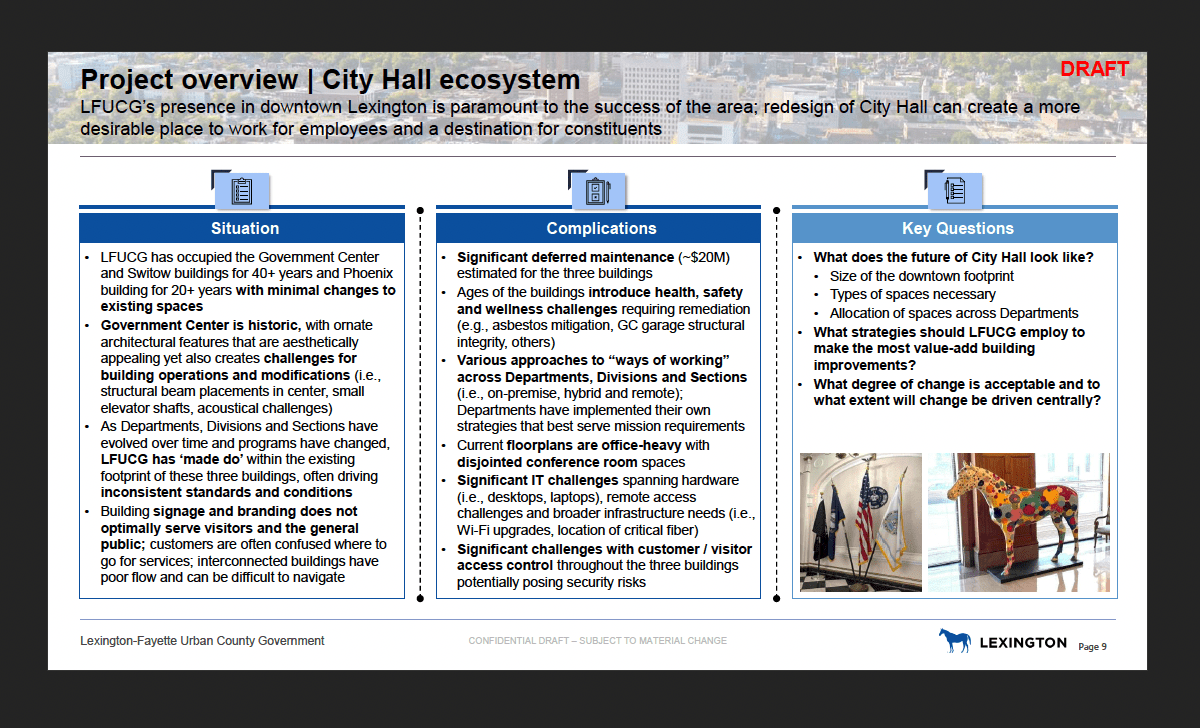LFUCG Considers Future City Hall Space Needs and Implementation Challenges

Lexington, Ky.–In a recent development, the Lexington-Fayette Urban County Government (LFUCG) released a draft of its deliberations on future space City Hall needs and the challenges associated with their implementation. The LFUCG, responsible for governing the Lexington-Fayette Urban County, is evaluating potential changes to their working environment and exploring avenues to optimize efficiency.
As part of this initiative, LFUCG has identified key questions that demand careful consideration as they transition from recommendations to practical implementation. These questions reflect the broader concerns surrounding change management and the adoption of innovative approaches within the organization.
One of the primary queries LFUCG faces is the identification of an individual who will spearhead the change management process, driving the organization towards a more open and collaborative work environment. This crucial role entails the responsibility of navigating potential hurdles while instilling a culture conducive to the proposed changes.
Furthermore, LFUCG is deliberating whether to embrace technological investments that facilitate enhanced remote work and hybrid collaboration. As the world becomes increasingly interconnected, the consideration of such investments demonstrates LFUCG’s commitment to adapt to the evolving work landscape.
However, the path to implementation presents its own set of challenges. Among them is the decision of whether LFUCG should vacate the existing Government Center (GC), considering the potential ramifications of leaving the space unoccupied for an extended period. The repercussions of such a move include potential economic and public challenges that may arise from leaving a prominent structure vacant.
Another consequential query is whether LFUCG should consider the acquisition of a large downtown office building, despite the implications of removing the subject property from the tax rolls. Such an acquisition could offer the LFUCG a strategic advantage in terms of space utilization but would necessitate careful consideration of the associated financial trade-offs.
Should LFUCG opt for ground-up construction, another consideration is identifying parts of the city that could benefit from revitalization through a large-scale development project. This avenue could not only address LFUCG’s space requirements but also serve as a catalyst for rejuvenation in specific areas of Lexington-Fayette.
In a bid to alleviate upfront capital requirements for potential options, LFUCG is contemplating exploring public-private partnership agreements. Such agreements could provide a mutually beneficial solution, reducing the initial financial burden for options B, C, or D while leveraging the expertise and resources of private entities.
These pivotal questions, as outlined by LFUCG, underscore the critical decision-making process ahead as the organization moves from future space need recommendations to implementation. The answers to these inquiries will shape the future working landscape of LFUCG and potentially influence the wider urban community they serve.
LFUCG remains committed to carefully assessing each question, considering the potential benefits, drawbacks, and impacts on stakeholders. The ultimate goal is to create an efficient and modern working environment while addressing the practical challenges and ensuring the best use of available resources.
As this process unfolds, all eyes are on LFUCG to witness how they navigate these intricate considerations and transform their vision into a tangible reality. The decisions made will undoubtedly shape the future trajectory of LFUCG and reverberate through the urban county of Lexington-Fayette.
The Current City Hall Complex: A Closer Look
The existing City Hall complex, as revealed in the LFUCG presentation, consists of three office buildings: Government Center, Switow, and Phoenix. These structures serve as the administrative hubs for the Lexington-Fayette Urban County Government and house a significant portion of the organization’s workforce.

Government Center, located at 200 E Main St, boasts a substantial footprint of approximately 153,638 gross square feet (GSF). This building accommodates a total of 329 occupants, including employees from various departments within LFUCG. The headcount encompasses 280 workseats, which encompass both offices and cubicles. It is worth noting that employees situated in retrofitted offices within the Government Center garage are considered part of the Government Center employee count. Furthermore, the Compliance/New Accounts/LexServ Administration section employees from the Finance and Revenue division are also stationed in both the Government Center and Switow buildings, and their totals are included in the Government Center count.
Phoenix, situated at 101 E Vine St, spans approximately 83,490 GSF. This building houses a total of 199 occupants, with 202 workseats available. Although specific details about the departments operating within Phoenix were not provided in the presentation, it is a vital component of LFUCG’s administrative infrastructure.
Switow, located at 212 E Main St, comprises a comparatively smaller space, encompassing approximately 11,820 GSF. It serves as the workplace for 33 occupants, with 41 workseats available. While the presentation does not elaborate on the departments situated in Switow, it is evident that this building plays a role in accommodating LFUCG’s workforce.
Collectively, the current City Hall complex covers an estimated 248,948 GSF. Within this area, a total of 561 occupants are distributed across 523 workseats, which include both offices and cubicles. Additionally, it is noteworthy that the majority of support spaces, such as break areas and conference rooms, are located within individual department suites.

Top graphic: Programming and Space Needs for City Hall, project overview (LFUCG)
Recommended Posts

Kamala Harris needs a VP candidate. Could a governor fit the bill?
Fri, July 26, 2024
After cyber-attack on Jefferson County Clerk, Fayette counterpart discusses precautions
Fri, July 26, 2024
An eastern Kentucky animal shelter is swelling this summer
Fri, July 26, 2024
